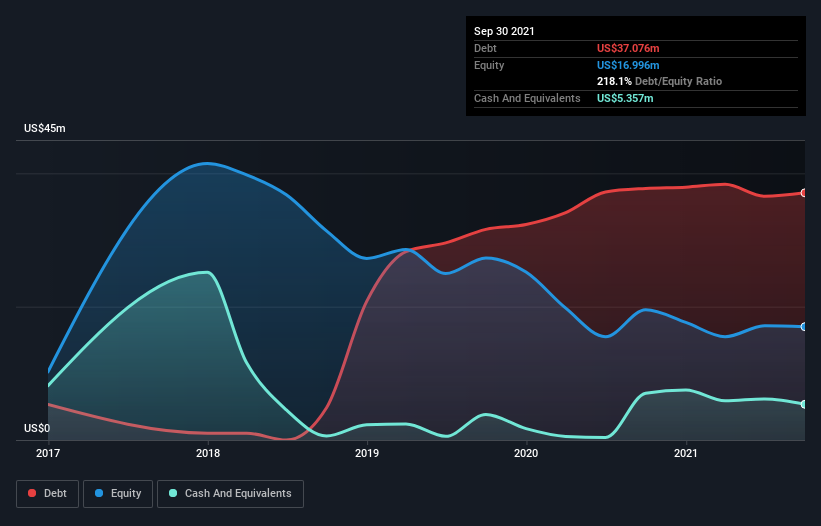Howard Marks put it nicely when he said that, rather than worrying about share price volatility, 'The possibility of permanent loss is the risk I worry about... and every practical investor I know worries about.' So it might be obvious that you need to consider debt, when you think about how risky any given stock is, because too much debt can sink a company. Importantly, Titan Mining Corporation (TSE:TI) does carry debt. But is this debt a concern to shareholders?
Why Does Debt Bring Risk?
Debt and other liabilities become risky for a business when it cannot easily fulfill those obligations, either with free cash flow or by raising capital at an attractive price. Ultimately, if the company can't fulfill its legal obligations to repay debt, shareholders could walk away with nothing. However, a more usual (but still expensive) situation is where a company must dilute shareholders at a cheap share price simply to get debt under control. Of course, debt can be an important tool in businesses, particularly capital heavy businesses. The first step when considering a company's debt levels is to consider its cash and debt together.
Check out our latest analysis for Titan Mining
What Is Titan Mining's Net Debt?
As you can see below, Titan Mining had US$37.1m of debt, at September 2021, which is about the same as the year before. You can click the chart for greater detail. However, it does have US$5.36m in cash offsetting this, leading to net debt of about US$31.7m.

How Strong Is Titan Mining's Balance Sheet?
According to the last reported balance sheet, Titan Mining had liabilities of US$42.7m due within 12 months, and liabilities of US$18.1m due beyond 12 months. Offsetting these obligations, it had cash of US$5.36m as well as receivables valued at US$3.67m due within 12 months. So it has liabilities totalling US$51.8m more than its cash and near-term receivables, combined.
This deficit is considerable relative to its market capitalization of US$68.8m, so it does suggest shareholders should keep an eye on Titan Mining's use of debt. This suggests shareholders would be heavily diluted if the company needed to shore up its balance sheet in a hurry. There's no doubt that we learn most about debt from the balance sheet. But it is Titan Mining's earnings that will influence how the balance sheet holds up in the future. So if you're keen to discover more about its earnings, it might be worth checking out this graph of its long term earnings trend.
In the last year Titan Mining wasn't profitable at an EBIT level, but managed to grow its revenue by 143%, to US$51m. So its pretty obvious shareholders are hoping for more growth!
Caveat Emptor
Even though Titan Mining managed to grow its top line quite deftly, the cold hard truth is that it is losing money on the EBIT line. Indeed, it lost US$2.6m at the EBIT level. When we look at that and recall the liabilities on its balance sheet, relative to cash, it seems unwise to us for the company to have any debt. So we think its balance sheet is a little strained, though not beyond repair. However, it doesn't help that it burned through US$961k of cash over the last year. So to be blunt we think it is risky. When analysing debt levels, the balance sheet is the obvious place to start. However, not all investment risk resides within the balance sheet - far from it. To that end, you should learn about the 3 warning signs we've spotted with Titan Mining (including 1 which shouldn't be ignored) .
When all is said and done, sometimes its easier to focus on companies that don't even need debt. Readers can access a list of growth stocks with zero net debt 100% free, right now.
Valuation is complex, but we're here to simplify it.
Discover if Titan Mining might be undervalued or overvalued with our detailed analysis, featuring fair value estimates, potential risks, dividends, insider trades, and its financial condition.
Access Free AnalysisThis article by Simply Wall St is general in nature. We provide commentary based on historical data and analyst forecasts only using an unbiased methodology and our articles are not intended to be financial advice. It does not constitute a recommendation to buy or sell any stock, and does not take account of your objectives, or your financial situation. We aim to bring you long-term focused analysis driven by fundamental data. Note that our analysis may not factor in the latest price-sensitive company announcements or qualitative material. Simply Wall St has no position in any stocks mentioned.
Have feedback on this article? Concerned about the content? Get in touch with us directly. Alternatively, email editorial-team (at) simplywallst.com.
About TSX:TI
Titan Mining
A natural resource company, acquires, explores, develops, produces, and extracts mineral properties.
Good value with acceptable track record.
Market Insights
Community Narratives



